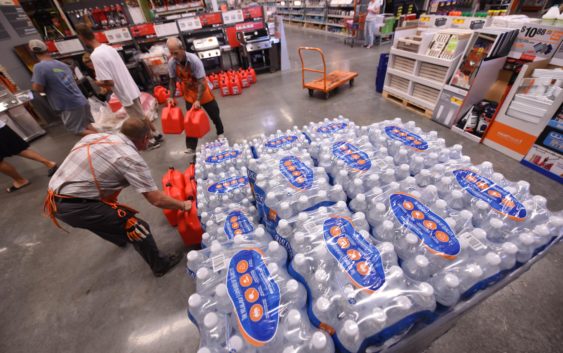- Couple accused of creating videos of young girls using hidden cameras at The Woodlands Mall, Hurricane Harbor
- Couple accused of creating videos with hidden cameras at The Woodlands Mall, Hurricane Harbor
- The Texanist: Texas Gets More Tornadoes Than Any Other State, but Don’t Freak Out
- U.S. Supreme Court says Texans can sue state for flood damage
- This is how many hurricanes NC State researchers predict this year
11 a.m. update: Wilmington-area could see greater impacts from Hurricane Dorian

N.C. Gov. Roy Cooper declared a state of emergency Friday to allow farmers, emergency services to prepare for any potential impacts next week
WILMINGTON — Southeastern North Carolina got a sense of deja vu Saturday morning as the region found itself inside the dreaded cone of uncertainty for Hurricane Dorian.
By late Friday, Hurricane Dorian had intensified to a category 4 storm with 140 mph maximum sustained winds. By 11 a.m. Saturday, the winds had increased to 145 mph and the National Hurricane Center’s latest update put the eye of the storm just south of the Carolina coast around 8 a.m. Thursday morning.
As of the 11 a.m. trek, the storm was moving west at 8 mph. Hurricanes conditions are expected across the northwestern Bahamas by Sunday, with tropical storm winds beginning Saturday night. Tropical storm-force winds could arrive in Southeastern North Carolina by Tuesday night.
However, with such drastic changes in the track of the storm over the past few days, the National Weather Service’s Wilmington is cautioning local residents not to panic, but be vigilant.
“The track will definitely continue to change, but to what degree we don’t know,” said meteorologist Jordan Baker. “It’s been changing so much, and we still have a lot to go. But we want people to have a plan now, so if we get closer and there looks like there could be impacts, you will be ready.”
Baker said it’s a little too early to know what kind of rain or wind impacts could be seen locally.
Gov. Roy Cooper declared a state of emergency for North Carolina on Friday afternoon ahead of the potential impacts the state could feel from Hurricane Dorian next week.
Although the storm is too far away to make concrete predictions about the impacts that could be seen on the North Carolina coast, Cooper’s declaration waives certain transportation restrictions to help farmers and support relief efforts in advance of the storm.
“Hurricane Dorian tracking toward the coast of Florida is a timely reminder to get your emergency plans and supplies ready,” Cooper said in a release. “North Carolinians should make sure they are ready for this storm and for all types of emergencies and disasters.”
Dorian’s track is still uncertain, but forecasters are warning it’s possible the storm will bring significant rainfall to the Cape Fear region by late next week.
At 3 p.m. Friday, Brunswick County issued a statement citing the NWS’ immediate concerns as ongoing tidal/coastal flooding and the increased threat for rip currents during Labor Day weekend. Coastal North Carolina residents who hit the beaches for the long weekend should be on the lookout for rough surf and strengthening rip currents beginning Saturday.
University of North Carolina Wilmington announced Friday it was monitoring the storm but did not anticipate any closures or delays early next week.
More long-range concerns through late next week could include flooding, rain, storm surges, tornadoes and damaging winds — all depending on how Dorian’s track develops over the coming days.
Due to the high uncertainty of the storm’s path, coastal residents should prepare their hurricane kits now and continue to monitor the storm throughout the weekend.
Stay up to date on news as it happens: Sign up for our free breaking news email alerts
How to prepare before a storm hits:
Necessities
• Water. 1 gallon per person, per day, prepare for a minimum of three days.
• Battery-operated television or radio.
• Extra batteries
• Manual can opener
• Local maps
• Flashlights and waterproof matches
• Cellphone with chargers, inverter or solar charger
• Toilet paper
• Baby supplies
• Cash (ATMs may not work after the storm)
• Rain gear (including a hat)
• Bleach or water purification tablets
• Soap and detergent
• Moist towelettes, garbage bags and plastic ties for personal sanitation.
• Charcoal/lighter fluid or portable camping stove
• Disposable plates, glasses and utensils
• Ice chest and ice
• Valuable papers — insurance information, passports, Social Security cards, bank account and credit card numbers, wills, deeds, etc. — or copies, in a waterproof bag
• Prescription and other necessary medicines
• Blankets, tarp and masking tape
• Dust mask to filter contaminated air, plastic sheeting and duct tape.
• Three day’s worth of clothing, sleeping bags
• First-aid kit, aspirin or pain reliever, anti-diarrhea medication, scissors, tweezers, bug spray
• Feminine supplies and personal hygiene items
• Fire extinguisher — ABC type
• Extra pair of eyeglasses
• Extra house, car keys
• Tools: Shut-off wrench, pliers
• Needles, thread
• Whistle
• Signal flare
• Games,books for entertainment
• Petcare: leashes, pet carriers, food
• Sunscreen and sunglasses
Food
• Baby food, baby formula, powdered milk
• Canned meats (Spam, chicken, ham)
• Canned fish (tuna, sardines)
• Canned meals: spaghetti, soup, stew, chili
• Canned fruits and vegetables
• Cereal, crackers and cookies
• Instant coffee, tea bags, sodas, juice
• Granola bars, nuts, trail mix
• Peanut butter and jelly
• Sugar, salt, pepper
Sources: American Red Cross; FEMA; N.C. Emergency Management